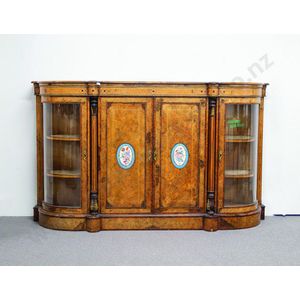Burr Walnut Credenza with Sevres Style Painted Panels
A fine 19th century burr walnut amboyna parquetry and ormolu credenza with crossbanded top, central doors inset with Sevres style floral painted oval panels flanked by outset columns with acanthus leaf terminals and capitals, glazed cupboard to each end, 183 cm length
You must be a subscriber, and be logged in to view price and dealer details.
Subscribe Now to view actual auction price for this item
When you subscribe, you have the option of setting the currency in which to display prices to $Au, $US, $NZ or Stg.
This item has been sold, and the description, image and price are for reference purposes only.
- Burr - Burr (or in the USA, burl) is the timber from the knotted roots or deformed branch of the tree, which when cut, displays the small circular knots in various gradations of colour. It is always cut into a decorative veneer, most commonly seen as burr walnut on 19th century furniture.
- Parquetry - Parquetry is inlay laid in geometric patterns, the contrast being achieved by the opposing angles of the grain and veneers. The herringbone pattern is the most commonly used in flooring, but this is almost never seen in furniture - the patterns used are more complex and unlike flooring, can include several different varieties of timber.
- Amboyna - Amboyna is a tree native to Indonesia (named after the Indonesian island of Ambon) and South East Asia, and when harvested the timber has a fragrant rose-like scent, and is of a rich brown colour, usually harvested from the burl of the tree with "birds-eye" markings . In furniture is is usually veneered and used for decorative effects on top quality pieces.
- Crossbanding - Crossbanding is a decorative technique used in furniture-making, where thin strips of wood, known as crossbands, are applied to the surface of a piece of furniture to create a decorative border or inlay. The crossbands are typically made of a different type of wood or a different color than the main piece of furniture, and are applied in a geometric pattern, such as a checkerboard or herringbone design.
Crossbanding was a popular decorative technique in furniture-making from the 17th to the 19th centuries, particularly in the Baroque, Rococo, and Chippendale styles. It was often used to create intricate patterns and designs on the surfaces of tables, desks, cabinets, and other pieces of furniture. The crossbands were often made of exotic woods, such as ebony or rosewood, which were imported from other parts of the world and were highly prized for their rich colors and patterns. - Acanthus - A stylized leaf motif, one of the primary decorative elements of classical Greek and Roman architecture, derived from the genus of flowering plants in the family Acanthaceae, native to tropical and subtropical regions of the Mediterranean area. It is a common element in classical Greek and Roman design, and is often seen in Corinthian and Composite order columns and used as a decorative element in English, European and Australian furniture, particularly on the curve of a leg, and as decoration for a corbel.
- Panels - Timber pieces, usually of well-figured wood either recessed or applied over the frames of doors and as decoration elsewhere in the carcase of cabinet furniture. The panels may take a variety of shapes rectangular, square, shield shape, oval, half-round or in the form of Egyptian pylons.
- Ormolu - Ormolu was popular with French craftsmen in the 18th and 19th century for ornamental fittings for furniture, clocks and other decorative items. True ormolu is gilt bronze, that is bronze that has been coated with gold using a mercury amalgam. Due to the health risks associated with using mercury, this method of creating ormolu was discontinued in France in the 1830s. A substitute was developed consisting of about 75% copper and 25% zinc, however it was inferior to the bronze version. It was often lacquered to prevent it tarnishing.
- Column - An architectural feature sometimes used for decorative effect and sometimes as part of the supporting construction. Columns should generally taper slightly towards the top. They may be plain or decorated with carving, fluting or reeding. Columns may be fully rounded or, more commonly, half-rounded and attached with glue, screws or pins to the outer stiles of doors, or the facing uprights on cabinets and bureaux.
This item has been included into following indexes:
-
cabinets, material
- ormolu and bronze mounted 224
- painted 150
- walnut 665
- credenza - without mirror back 118
